If one day you should lie on the bank pounding your fists into the sand in frustration over the lack of fish and someone sneaks around the corner offering you a chartreuse coloured fly, perhaps it's German Kai Nolting who brings you the fly that will save your day.
It was late October 2004. Two of my friends stayed with me on Fyn, a small island in the middle of Denmark. We had a week full of fly-fishing ahead of us and were keen on doing the first casts. The weather was warm; the sun was shining from a clear blue sky and the wind was almost calm.
We stayed in the area near Bogense in the north of Fyn, in a comfortable house. Everything was nearly like we had expected it.
Everything except the fish.
Especially their behaviour regarding taking the fly - or unfortunately not taking the fly.
We saw sea trout splashing and saw their dorsal fins and tails close to the edge of the water.
We fished large flies and small flies. We were retrieving the line in fast strips and in slow strips. We were changing places and tried every tactic we could think of, but couldn't get a single take at all.
|
|
|
|
|
|
|
|
|
|
|
|
|
|
|
|
|
|
|
|
|
|
|
|
After two fruitless days I felt a strong resignation. With a sobbing sound I fell to my knees close to the water and pounded my fists into the sand.
After 10 minutes lying there in pure desperation, something from deep down in my weary angler's head told me to consult my fly box one last time.
After a coffee break I followed this miraculous inspiration out of nowhere and found two unbelievable ugly flies - bright green body, orange tail and a grizzly-hackle tied around the body.
After storing my wet handkerchief in my pocket, I took a closer look on the illuminating flies and swore to do good for every desperate angler I'd meet, if these flies caught me a fish.
Making sure no one saw me, I tied the forbidden fly on.
With a feeling of "if I'm in guilty I will pay" I entered the water, made a few casts and - immediately caught my first sea trout!
Not a big one, but a fish!
Happy as rarely before I climbed out of the water to find my friends. Free from tears and frustration I stumbled around the next cliff and saw my good friend Rüdiger lying on the ground, pounding his fists into the sand. After an infusion of a good amount of coffee a gave him a green fly...
Since that day I've caught so many fish on this green fly, which Martin has called "Kai's Green Terror", that I always carry a good amount of these flies in my fly box.
So, if one day you should lie on the bank pounding your fists into the sand in frustration and someone sneaks around the corner offering you a chartreuse coloured fly, perhaps it's me.
But if you would like to tie some of these flies yourself (since I can't hang around the world's waters all the time), please read the instructions in this article.
- Log in to post comments






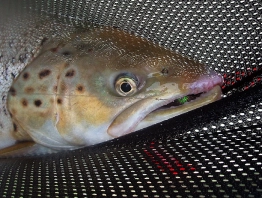
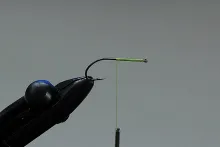


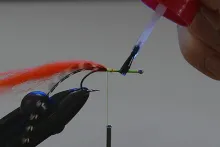










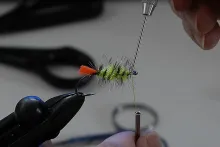






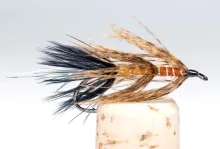


In the united states
In the united states we call this fly a wooly worm,one of the first flies I learned to tye " holds a warm spot in my heart",caught a lot of different species of fish on every color you can think of,My first stellie was caught on a # 10 pink wooly worm with a red tail over 20 years ago, good to see the simple flies still catch fish,I use everything from flash chenille,cotton chenille,dubbing,and yarn for the body to yarn or hackle fibers for the tail weighted or not you can't go wrong with a wooly worm,add a marabou tail a "wala" wooly bugger how simple is that.
Finally a website th
Finally a website that finally gives step by step instructions for fly tying with good quality close-up pics.
I hope to tie Kai's Green Terror and try it salmon fishing.
Here in the U.S.A. w
Here in the U.S.A. we call this a wooly worm and tie them without trimming the hackle. Also weighted and unweighted. The longer hackle has a lot of movement in the water. It can be fished wet or dry
Very similar to the
Very similar to the one I use here in eastern Canada. Works very well with brook trout in rivers and brooks. I also tie them weighted.
Hi guys,
Sorry fo
Hi guys,
Sorry for my late responds, but a bad flu brought me down.
Normally I fish the fly wet, directly under the surface, because of no weight.
But one time, during my summer holidays in Denmark 07 in the very early morning, I saw rainbows cruising around just under the surface and try to fish it dry ââ¬â and it worked properly.
But I think this was a quit an unusual behaviour.
When fishing the fly wet, I retrieve it in small strips and from time to time I diversify the speed from low to medium low.
Until now Iââ¬â¢ve got very low experience with fishing the fly in rivers and lakes, so perhaps itââ¬â¢s up to you to help with some practise and please let me know of your results.
Kind regards
Kai
It hooks steelhead a
It hooks steelhead aswell, caught a 6lber last weekend
It hooks steelhead a
It hooks steelhead aswell! caught a 6lber on it last weekend
Thanks for the fly!
Thanks for the fly!
Few question: what is the way of fishing this fly? Was it tried in salt water only? What about lakes or rivers?
Thanks in advance!
Andriy
Do you fish it also
Do you fish it also as a dry fly?
Agree with the name
Agree with the name of the fly. I had a chance to hook couple of fish :)
cheers
Roolis